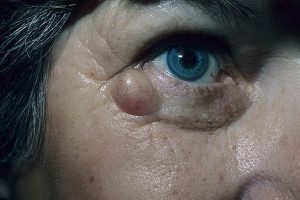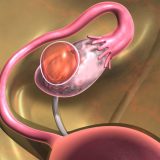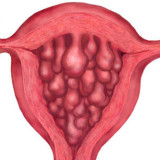An epidermal cyst is a benign skin cancer that develops from the epidermis. A common cause of epidermal cysts is trauma. This skin change is characterized by slow growth. The cyst resembles a round lump that easily glides under the skin, ranging in size from a few millimeters to several centimeters. Initially, it has a white or skin color, and eventually acquires a yellowish tint. Treating uninfected cysts under the skin involves cutting them along with the contents.

What causes an epidermal cyst?
An epidermal cyst (cystis epidermoidales) is a cyst containing keratin surrounded by an insert with the same layered system as in the epidermis. As a rule, these are small, soft or hard, easily gliding nodules under the skin. Often a black spot is visible in the central part, which indicates the closed mouth of the hair follicle.
Traumatic factor
Epidermal cysts often develop after trauma as a result of implantation of a fragment of the epidermis into the dermis. Changes usually affect young people or middle-aged people and are most often located on the head and face, neck, shoulders and chest.
Sometimes they can spontaneously secrete a white mass of keratin or undergo bacterial superinfection. The epidermal cyst most often affects the skin, although it may be a congenital lesion that occurs in the first development of the unborn child. Then these benign tumors are localized in the nervous system. Most of them are found in the thoracic and lumbar spine.
Multiple cysts on the skin that occur in childhood are a hallmark of Gardner’s syndrome. Gardner’s syndrome is a genetic disease characterized by the presence of polyps in the colon. Also, cystic formation can be part of basal cell nevus syndrome.
Symptoms of an epidermal cyst
Initially, cysts under the skin are small whitish or skin tubercles that do not hurt you. As a rule, patients do not pay attention to them. The first signs of anxiety appear when a change begins to become visible. Especially when the cystic mass is located on the head or neck and begins to grow actively, acquiring a yellowish tint.
When bacterial superinfection occurs, symptoms of inflammation appear: the skin swells, the lesions turn red, pain and discomfort appear.
Atheroma (sebaceous cyst) and other skin lesions
Atheroma is a sebaceous cyst of the skin that blocks the mouth of the sebaceous glands, causing inflammation of the skin. Inside such a cyst is not only keratin, but also elements of subcutaneous fat, hair follicle.
What is typical for an epidermal cyst:
- Squamous keratoma is a lump resulting from the rapid proliferation of keratocytes. Changes occur in places exposed to intense solar radiation, especially in the head and upper limbs. The papule is pink or flesh-colored and grows rapidly. Change disappears on its own within a few months;
- Cellular keratoma – also known as a Degos tumor. The nodule is red or brown, found on the lower extremities and has an exfoliating surface. This benign tumor is rare and requires surgical removal.
- Tricuspid cyst – like an epidermal cyst, it is filled with keratin, but the lining resembles the outer shell of the hair. Most often this occurs on the scalp. Multiple cysts can be inherited genetically.
Skin atheromas should also be distinguished from piglets – multiple epidermal cysts of idiopathic nature. It occurs mainly around the eyelids and cheeks. These are white papules with a diameter of up to 2 mm. They occur as a result of damage to the sweat gland or an insufficiently developed sebaceous gland.
How is an epidermal cyst treated?
Epidermal cysts often empty or disappear spontaneously. Home remedies that increase the likelihood of spontaneous removal of cysts include regular skin peeling. Unfortunately, this approach is associated with a high relapse rate.
Any skin disorder should be examined by a doctor who will diagnose and prescribe the correct treatment. For uninfected cysts, surgery under local anesthesia is possible. This includes the complete removal of the cyst along with its contents and mucous membrane. This ensures that it does not grow back. However, incomplete removal increases the risk of relapse and other dangerous changes, such as cancer. Cryotherapy, also known as freezing, is also an effective way to get rid of unwanted cysts.
Medecine treatment
If there is an infection in the epidermal cyst, then the appropriate course of action is antibiotic therapy, which usually lasts from 7 to 10 days. After the inflammation goes away, you can finally get rid of the cystic formation.












